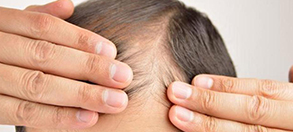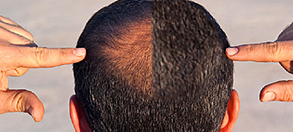For those experiencing hair loss, medication is one of the most popular treatment options. People typically begin with topical treatments like minoxidil (better known as Rogaine) because it can be purchased over-the-counter without a prescription.
If minoxidil doesn’t work to their satisfaction, they usually talk to their doctor about the oral medication finasteride (Propecia). Finasteride is the first medication of its kind, and has proven to be effective in the vast majority of people who take it.
But those who have tried almost every medication on the market (shampoos, creams, supplements, etc.) are usually skeptical that an oral medication would do any good. And rightly so — there are a lot of products that aren’t effective whatsoever and plenty of people have wasted far too much money on them.
So what makes this solution any different? Does finasteride actually work?
We’re proud to be the hair transplant surgeons of choice for pro athletes, actors & celebrities.
Contents
How Propecia Was Developed
Sometimes during clinical trials in humans, drug companies discover side effects that are actually a bit helpful for unrelated ailments. Perhaps the most famous example is sildenafil citrate, better known as Viagra — a medication developed by Pfizer to treat high blood pressure and angina (chest pain often linked to heart disease).
During clinical trials, researchers found the sildenafil citrate wasn’t doing much to help people’s blood pressure, but men were experiencing… well, a different, unexpected side effect. Of course, this led to the repurposing and redevelopment of said drug.
Like Viagra and a few other medications, finasteride isn’t used for its original intended purpose. Merck developed a medication called Proscar (in 5mg doses) to treat enlarged prostate glands. As with Viagra, participants in the clinical trials reported a fortunate side effect. This time, it was additional hair growth.
Because the drug was already approved for a different purpose, Merck decided to repurpose it and create the first hair loss medication in a pill form. (Minoxidil was already on the market.)
After additional clinical trials to determine dosage in 1997, the FDA approved a 1mg dose to treat male pattern baldness, and Propecia was born. Propecia became the first drug of its kind to treat androgenic alopecia and remains extraordinarily popular today.
Does Propecia Actually Work?
With the sheer number of products promoted as hair loss solutions marketed to those suffering from male pattern baldness, it’s perfectly understandable that people would question the efficacy of finasteride.
The good news is, finasteride is very effective in the majority of people who take it to treat their male pattern baldness.
Study after study — totaling thousands of men observed over a period of up to five years — has shown that Propecia not only slows the process of hair loss, but it actually helps regrow some of the hair the person has already lost.
In fact, clinical trials showed that the progression of hair loss stopped in 86% of participants. Furthermore, 65% experienced a “substantial” increase in hair growth. There’s even evidence to suggest that finasteride is more effective in year five of use than in year one.
Because of its efficacy in such a large portion of those who take it, finasteride is often the first recommendation doctors give to patients experiencing male pattern baldness who are interested in seeking treatment — even before over-the-counter treatments like minoxidil.
It’s important to note that finasteride is most effective in those with mild to moderate hair loss. Frankly, there’s less ground to cover if the person is earlier on in the hair loss process. If the patient has lost too much hair, the effects will barely be noticeable.
How Does Finasteride Work?
The key to Merck’s success with finasteride lies in the drug’s ability to reduce a very specific enzyme called 5-alpha-reductase. This is important because 5-alpha-reductase is what creates the byproduct of testosterone believed to be the main culprit behind male pattern baldness: dihydrotestosterone (DHT).
While some hair loss is caused by hormone imbalances, illness or stress, male pattern baldness is caused by hair follicles that are sensitive to DHT. DHT causes hair follicles to shrink over time, and as they shrink, they produce fewer hairs. (While we often think that one hair follicle equals one hair, each follicle can produce anywhere from one to five hairs.)
As the follicles shrink, the hairs they produce may change in texture and thickness, and they’ll eventually stop producing hairs altogether. And because the follicles on the top and crown of the head tend to contain DHT-sensitive follicles, we often see male pattern baldness begin with a receding hairline on the forehead or thinning hair at the crown (the infamous “bald spot”).
In later stages of male pattern baldness, men are typically left with a “horseshoe” pattern, with remaining hair only on the sides and back of the head — although some men also experience thinning hair in those areas as well.
But by reducing the 5-alpha-reductase enzyme, Propecia reduces the prevalence of DHT, which means the drug is essentially eliminating the cause of hair loss in the first place (again, assuming the hair loss is being caused by DHT and not another health issue).
Because finasteride consistently reduces the 5-alpha-reductase enzyme, it takes some time before the effects start to become noticeable — typically about six months, but it could take up to one year. Stopping the medication will result in increased production of the 5-alpha-reductase enzyme again, which will lead to additional DHT production, and of course, hair loss.
Any hair re-grown as a result of finasteride will fall out, and hair loss will resume as it had been occurring prior to the patient taking the medication. Therefore, most people who begin taking Propecia intend to continue taking it for the foreseeable future.
If the patient hasn’t seen any meaningful results after taking finasteride for one year, it’s unlikely that they ever will. In this case, the patient may be one of the small percentage of men in which Propecia is ineffective. At this point, the prescribing doctor will likely advise him to stop taking the medication and look into hair transplants (like follicular unit extraction) instead.
Finasteride for Women’s Hair Loss (Not FDA Approved)
Propecia is not approved by the FDA for use in women and we will not prescribe it for our female patients. Considering its effectiveness (and FDA-approval) for use in men, one would assume it would also work for women, assuming that their hair loss is caused by the shrinking of DHT-sensitive hair follicles. However this drug is a category X (known to cause birth defects) and therefore has never gained FDA clearance for use in women.
If your hair loss is determined to be female pattern baldness, your physician can recommend over-the-counter minoxidil or other prescribe medication for you — though it will not be finasteride. There are other medications intended for completely different purposes that are also anti-androgens and tend to block the production or absorption of DHT.
Studies have been conducted on women and dosages have been experimented with. For example, a study conducted from 2007 to 2011 observed 256 patients diagnosed with female pattern hair loss who took 5mg of finasteride for the specific purpose of studying adverse effects.
It’s very important to note that women who are pregnant, or attempting to become pregnant should not, under any circumstances, take finasteride. Propecia is considered a Category X drug for pregnancy risk, meaning that there’s reason to believe the medication causes birth defects. In this case, external genitalia abnormalities in a male fetus were reported in a study performed on animals.
Finasteride Side Effects
Propecia is largely well-accepted by those who take it. However, some side effects are possible with any drug. Finasteride has a variety of possible side effects, ranging from serious to innocuous.
Most commonly, some men experience lower libido or the inability to have or keep an erection. Others experience common cold symptoms, like a runny nose, drowsiness or congestion. The good news is that these side effects tend to dissipate as the body adjusts to the medication.
However, some more serious side effects are possible. If you experience any of the following while taking finasteride, contact your doctor immediately:
- Chills
- Confusion
- Cold sweats
- Dizziness or lightheadedness when standing up
- Swelling in your face or extremities
- Tingling in your hands or feet
- Breast enlargement or tenderness
- Rashes or hives
- Unusual weight gain or loss
As always, if you have any questions while taking a medication, you should contact your doctor.
What if Finasteride Doesn’t Work?
If you try finasteride for one year without any noticeable hair growth, a hair transplant is likely to be your next step. The technology hair transplant specialists use has greatly improved over the past decade — moving from a “strip” procedure (where a strip of your scalp is physically removed and relocated) to more precise follicular unit extraction (FUE) technique.
Those who’ve undergone this procedure are largely thrilled with their results. But don’t take our word for it — check out the before and after photos and see for yourself.
If you’re considering FUE, get in touch with us today and submit your virtual consultation. We’d love to discuss your treatment options with you!


